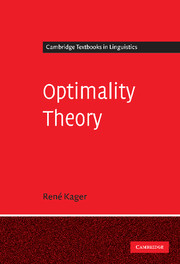Book contents
- Frontmatter
- Contents
- Preface
- 1 Conflicts in grammars
- 2 The typology of structural changes
- 3 Syllable structure and economy
- 4 Metrical structure and parallelism
- 5 Correspondence in reduplication
- 6 Output-to-output correspondence
- 7 Learning OT grammars
- 8 Extensions to syntax
- 9 Residual issues
- References
- Index of languages
- Index of subjects
- Index of constraints
5 - Correspondence in reduplication
Published online by Cambridge University Press: 05 June 2012
- Frontmatter
- Contents
- Preface
- 1 Conflicts in grammars
- 2 The typology of structural changes
- 3 Syllable structure and economy
- 4 Metrical structure and parallelism
- 5 Correspondence in reduplication
- 6 Output-to-output correspondence
- 7 Learning OT grammars
- 8 Extensions to syntax
- 9 Residual issues
- References
- Index of languages
- Index of subjects
- Index of constraints
Summary
Introduction
A central idea of OT is that the optimal output form arises from competition of markedness constraints and faithfulness constraints. Markedness constraints require that output forms match certain segmental or prosodic targets. Faithfulness constraints require that outputs be identical to their lexical inputs, each militating against some type of change – segment deletion, segment insertion, or featural changes. Both constraint types are inherently in conflict: markedness constraints trigger changes, while faithfulness constraints, by their very nature, oppose changes. Moreover, faithfulness constraints state their requirements about input–output relations in terms of correspondence.
This central idea will be extended in this chapter to a phenomenon that has been a hotly debated topic in pre-OT phonology (e.g. Wilbur 1973, Marantz 1982, Broselow and McCarthy 1983, McCarthy and Prince 1986, Shaw 1987, Uhrbach 1987, Steriade 1988a), and continues to be a focus of OT research: reduplication. From a purely morphological point of view, reduplication is ‘simply’ a kind of affixation, both in its morpho-syntactic contribution (it forms morphological categories, such as plural), and in its linear position with respect to the stem (preceding it, as a prefix, or following it, as a suffix). But from a phonological viewpoint, the special property of reduplication is that the reduplicative affix is not fully specified for segmental content. Its segmental content is copied from the stem that undergoes reduplication. Reduplication is therefore by its very nature a phenomenon involving phonological identity between the ‘reduplicant’ and the ‘base’ to which it adjoins.
- Type
- Chapter
- Information
- Optimality Theory , pp. 194 - 256Publisher: Cambridge University PressPrint publication year: 1999



